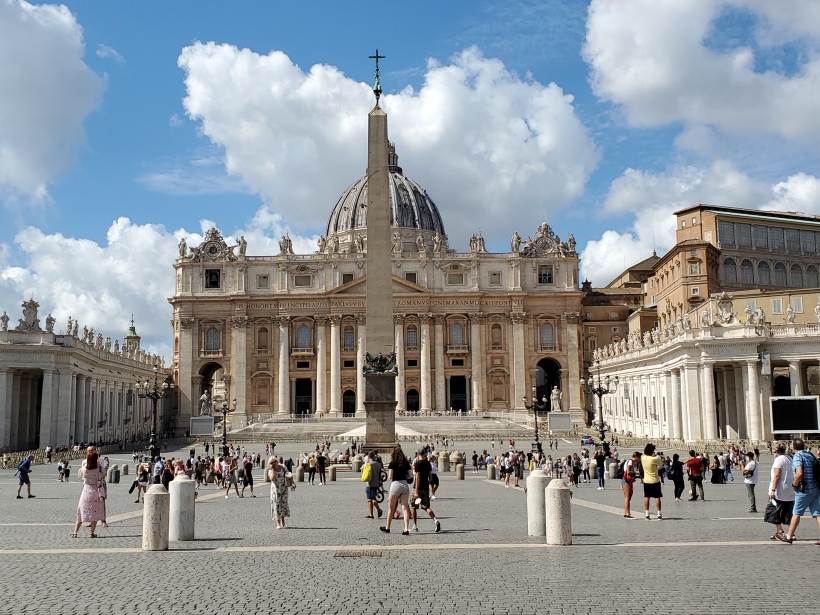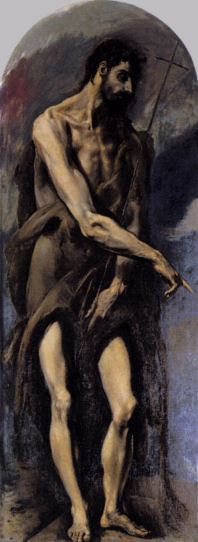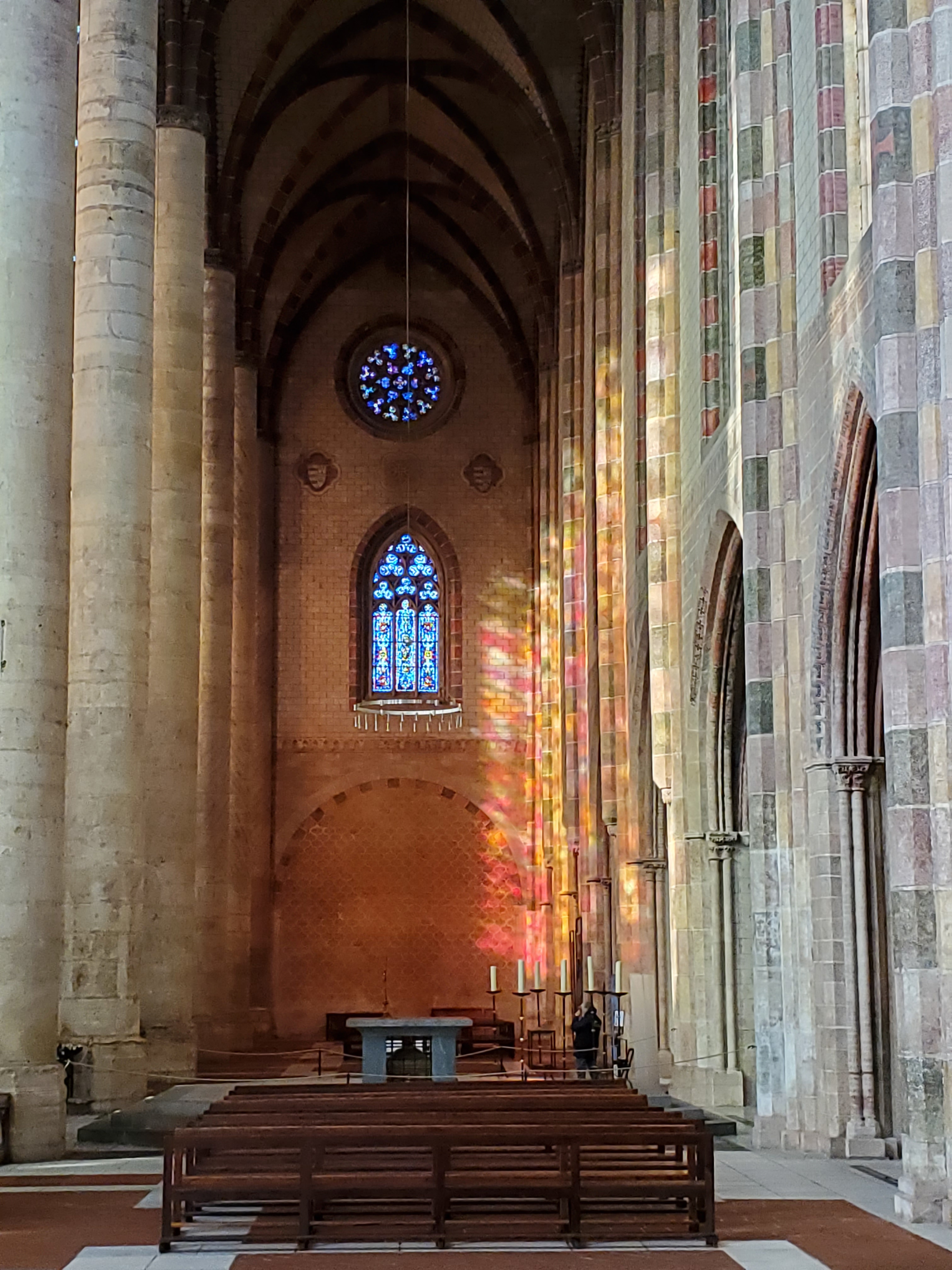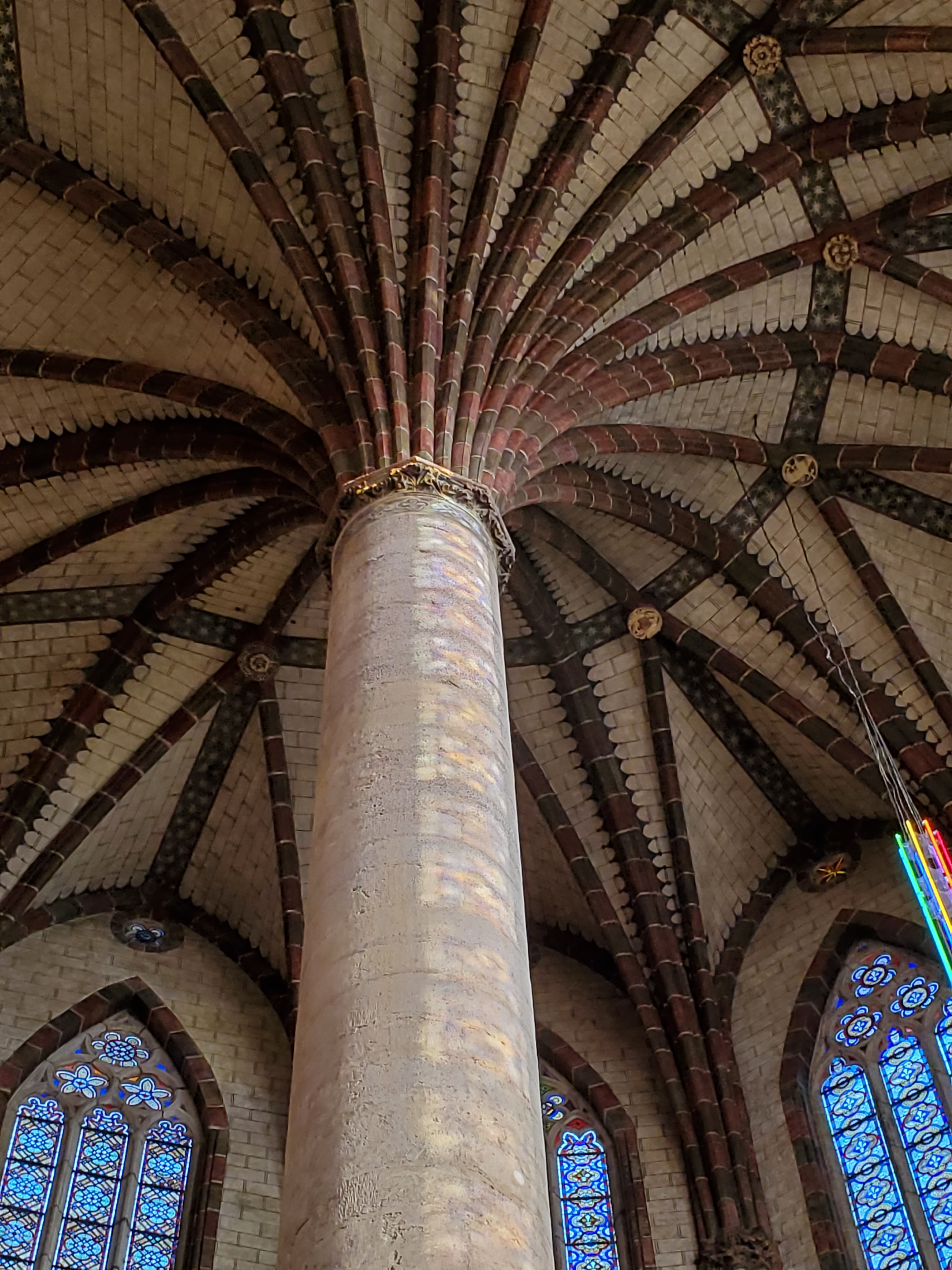
God possesses infinite life. He shares His life with us.
He gives us existence and capacities–including interior, spiritual capacities. We can feel, think, choose, love. And He unites Himself with us in Christ, in order to give us immortality and eternal friendship with Himself, the Source of everything beautiful and good.
We call our share in God’s life “grace.” It comes to us from Christ the divine eternal Son, through Christ the man, the son of Mary. God is the source of grace. The humanity of Christ is the instrument through which God gives us His grace.
The humanity of Christ: His human pilgrim life; His human death; His human resurrection; His human ascension into heaven. Through this humanity–Jesus Christ’s–we receive holiness from the unapproachable, true God. Grace.

Christ the God-man gave us the sacraments. He uses the sacraments of His Church to give us His grace. St. Thomas Aquinas employs this analogy for God’s giving of grace through Christ and the sacraments:
Imagine that our salvation and holiness were a wooden settee. God makes the settee out of wood, using His ‘hands’ (His humanity in Christ) and using His ‘tools’ (the sacraments.)
Could God Almighty share His eternal vitality with a particular human being using some ‘tool’ about which we Catholics know nothing? Certainly. God is God.
But, by the same token, can we say that we know of any way to get to heaven other than Holy Baptism and communion in Christ’s Church? No. We know of no other way. We would be dishonest as hell if we pretended that we did.

Holy Baptism comes from Jesus Himself. Before He ascended into heaven, He commanded His apostles to make disciples of all nations, “baptizing them in the name of the Father, and of the Son, and of the Holy Spirit.”
A Catholic baptism is a ritual washing. It is also an initiation ceremony, and a naming ceremony. In other words, Holy Baptism has certain aspects in common with similar rites in non-Christian religions.
But Baptism makes no sense at all, if you don’t understand it with reference to the Christian faith. A baptism is, first and foremost, an act of obedience to Jesus of Nazareth.
We obey Him in this way because we believe Him to be 1. God, 2. alive, 3. active in saving souls, through the sacraments which He gave to His Church.
The Church ministers Christ’s sacraments–as His instrument, a ‘tool’ in His hands. In the Church, we have particular individuals, sacred ministers, who can act in the person of Christ at Mass, and on other occasions. A particular sacrament, Holy Orders, makes a man a sacred minister within the ministering Church of Jesus Christ.

Sometimes when a sacred minister says “I” or “my,” he does not mean himself, in the sense of Joe Schmoe. He means, “I, Jesus.” In these moments, the sacred minister serves as a personal instrument of the Lord in the bringing about of a sacrament.
“This is My Body…This is My Blood,” would be the pre-eminent example.
To perceive by faith that Jesus Christ speaks these words at Holy Mass, using the priest as His personal instrument to bring about the consecration: that perception of faith is the key to embracing the Church’s sacraments for what they truly are. That is, perceiving Jesus acting in the priest at Mass = embracing the sacraments with Catholic faith.
—

Since I hold the Catholic faith, by God’s grace, I can say this: When I have, hundreds of times, applied water to someone in a kind of ritual cleansing, I believe that Christ has acted to bestow the sacrament of Holy Baptism. Every time.
Most, if not all, of the people present on those occasions have believed the same thing. We have all believed it, because the Church believes it. We have shared, in an imperfect manner, in the perfect faith of Holy Mother Church, the perfect minister of the sacraments of faith.
On all those occasions, I have always undertaken to say what the ritual book instructs me to say. Who would I be, to think that I could improve on that? Who am I to tinker with something so sacred, so hallowed by the centuries, and so crucially important?

All that said, perhaps you have heard, dear reader, about a serious problem that has arisen in the Church, regarding the ministering of Holy Baptism?
The problem has only just begun. It appears to be two-fold.
1. Many poor souls have to wonder if they are in fact baptized, since some ministers have said, “We baptize you in the name of the Father, and of the Son, and of the Holy Spirit,” instead of “I baptize…”
2. This hardship for earnest Catholics has led many to criticize, and even mock, our Church.
I think we can understand the criticism. Consider the situation: A family and their friends with a baby, coming to a Catholic church building (which has been dedicated for sacred use by a bishop), holding a child over a baptismal font (itself also consecrated for this holy purpose), participating in a ceremony conducted by a duly ordained Catholic clergyman, a ceremony in which the clergyman applies water to the child in a ritual cleansing (a ‘baptism’).
And the clergyman says:
“[first-person pronoun] baptize you in the name of the Father, and of the Son, and of the Holy Spirit.”
All the circumstances naturally lead everyone present to think: This is a Catholic baptism. No reason to doubt it.
That is, until the Vatican declares: If the first-person pronoun used was singular, all good. If plural, no baptism occurred.
You sure? Yes, we are absolutely sure no baptism occurred.
—

What if the minister said “we” by mistake? What if he was not a native speaker of the local language? Does what he meant to say count at all?
We Catholics have traditionally understood: What the minister means to say not only counts, but is the decisive thing. A sacrament occurs when the minister intends to do what the Church intends to do, by employing the necessary words and material.
Can I personally say that I have never flubbed the words? I can’t. I probably did, at some point. Over half the baptisms I have ever done have been in my second language.
But: However imperfectly I might have spoken, did I nonetheless habitually have the intention of celebrating the sacraments as Holy Mother Church celebrates them? Yes. I can say that without hesitation.
So I rest serene that my errors of diction have not impeded Jesus in His work.
Back to the Vatican declaration. In 2020, the Holy See responded to this question: Is a baptism conferred with the words, ‘We baptize you…’ valid? Answer: No. Anyone baptized with these words must undergo baptism again, as if he or she had never been baptized.
The pope approved the response. And the Vatican also published an explanation of its answer.

Let me say two things. This procedure is how things should work in the Church. The Holy See has the authority to settle questions like this. Also: only a very foolish cleric chooses to alter the words used to confer the sacraments.
That said, I humbly propose that there are three reasons why we might wonder about this Vatican judgment. I do not think it is correct. I think the Holy See should reconsider.
The three reasons:
1. In the first paragraph of the Vatican’s explanation of its ruling, they cite the Summa Theologica of St. Thomas Aquinas. The Vatican writes:
[In this case] the ancient temptation resurfaces, that is, to substitute for the formula handed down by Tradition other texts judged more suitable. In this regard, St. Thomas Aquinas had already asked himself the question, ‘Whether several people can simultaneously baptize?’ He replied negatively. (Citing ST III q67 a6)
Citing St. Thomas as an authority on this matter does not serve the purpose. Let me explain why.
St. Thomas considers the words used by the minister of a sacrament in questions 60, 64, 66, and 67 of Part III of the Summa (as well as in additional questions later on, considering sacraments other than Holy Baptism.)
In his considerations in these four questions, St. Thomas recognizes not one, but two, traditional formulas for conferring baptism.
In the Latin-speaking Church, the minister says, “I baptize you…” St. Thomas explicitly refrains from ascribing the phrase “I baptize you” to Christ’s institution. (Christ instituted the use of the name of the Holy Trinity, but Matthew 28:19 does not include ‘I baptize you.’)
In the Greek-speaking Church, on the other hand, the minister does not refer to himself at all. Rather he uses the passive voice, saying “[Name] is baptized in the name of…”
St. Thomas therefore opines:
“As to the addition of “I” in our form [the Latin], it is not essential. It is added in order to lay greater stress on the intention.” (emphasis added)
To lay greater stress on the intention. What intention? To do what the Church does in a baptism.
In other words, the sentence uttered by the minister is not some kind of incantation. It a verbal communication of his intention in acting as he does: that is, applying water to someone in a ritual washing.
What am I doing now? Am I rinsing the baby dandruff off your little scalp? No, “I baptize you in the name of the Father…”
To reiterate. St. Thomas: “I baptize” is not essential. It expresses the intention of the minister.
—
Okay, but doesn’t singular versus plural matter? What if a priest stood at the altar during the consecration at Mass and said: “Take this, all of you, and eat of it, for this is our body… Take this all of you, and drink from it, for this is the chalice of our blood.”
I think we would all agree that this would not result in the consecration of the Blessed Sacrament. It would be an ‘invalid’ attempt. It would result in a nonsensical, ridiculous situation, and the priest should have his head examined.
But St. Thomas’ explanation of the baptismal words (which takes the Greek Church practice into account) teaches us that the “I baptize” is not the same as the “My” of the Body and Blood at Holy Mass. There is no Mass without the priest using the exact words of Christ to consecrate the bread and wine. But the Greek-speaking Church has celebrated countless beautiful baptisms without anyone there saying “I baptize.”
The fact of the matter is: the Vatican addresses one situation in its response, while St. Thomas addresses something quite different in question 67, article 6, of Pars III.
In the cited article, St. Thomas concludes that several people cannot baptize at the same time. He gives this example:
Suppose a child to be in danger of death, and two persons present, one of whom is mute, the other without hands or arms. The one would have to speak the words, the other perform the act of baptizing.
He considers two possible explanations for why that would not work.
The first possible explanation:
Were they to say, “We baptize you…,” the sacrament would not be conferred because the form of the Church would not be observed, i.e., “I baptize you…”
St. Thomas unequivocally rejects this explanation for why it wouldn’t work. He writes:
This reasoning is disproved by the form observed by the Greek Church, since their words differ far more from our form than does ‘We baptize…”
According to St. Thomas, therefore, it is not the words “We baptize…” that renders it impossible for multiple people to baptize a baby. Rather it is the second explanation he proposes, namely:
If several concur in conferring one baptism, this seems contrary to the notion of a minister, for a man does not baptize save as a minister of Christ, as standing in His place; wherefore, just as there is one Christ, so should there be one minister.
In the case that sat before the Vatican for judgment, there was only one single minister. He substituted “we” for “I,” yes. But only he did the baptism. St. Thomas, in concluding that several cannot baptize, was addressing a different situation.
To my mind, this seriously compromises the integrity of the Vatican’s response. It also brings us to problem #2 with the Vatican’s explanation.

2. When a minister substitutes “we” for “I” when baptizing, who exactly does he mean by “we?” Do we know?
The Vatican explanation assumes that the ‘we’ the minister means is: the persons present at the ceremony. The Vatican puts it like this:
Apparently, the deliberate modification of the sacramental formula was introduced in order to express the participation of the family and of those present.
The Vatican rightly points out:
No group can make itself Church… The minister is a sign-presence of Him who gathers… The minister is the visible sign that the Sacrament is not subject to an arbitrary action of individuals or of the community, and that it pertains to the Universal Church.
Amen. Excellent points. But what if these points, too, do not actually address the case?
The Vatican also says this, in their explanation:
In the celebration of the sacraments, the subject is the Church, the Body of Christ together with its Head, that manifests itself in the concrete assembly. Such an assembly therefore acts ministerially.
What if, by “we,” the minister means this ministering Church? What if the “we” is not limited to the family and friends present as a mere human community, but actually refers to the Holy Mother? The “we” that is the Church.
If the minister has this ‘we’ in mind, would that change the situation? And perhaps allow for a different Vatican response?

This brings us to the third problem with the Vatican’s explanation for its negative response.
3. The Vatican assumes ill will on the part of the minister who says “we” instead of “I.”
The Vatican ascribes the rationale for the minister’s change of pronouns to “debatable pastoral motives,” adding: “Often the recourse to pastoral motives masks, even unconsciously, a subjective deviation and a manipulative will.”
The Vatican continues:
The minister’s intention to do what the Church does must be expressed in the exterior action constituted by the use of the matter and form of the sacrament.
They add: Substituting ‘we’ for ‘I’ does not…
manifest the communion between what the minister accomplishes in the celebration of each individual sacrament with what the Church enacts in communion with the action of Christ Himself…
Therefore, in every minister of baptism there must not only be a deeply rooted knowledge of the obligation to act in ecclesial communion, but also the conviction of St. John the Baptist: although many ministers may baptize, the virtue of baptism is attributed to Him alone on whom the dove descended.
Stirring words.
But who will test baptismal ministers for the necessary deeply rooted knowledge and conviction? How will we know when these necessary conditions are present?
And are you really saying that the mere substitution of ‘we’ for ‘I’ proves, in and of itself, that the necessary intention to do what the Church does is not there?
—
No clergyman should ever substitute any words in conferring a sacrament. The Vatican should emphasize our obligation to ‘say the black and do the red,’ as they say.
And maybe that is precisely what this Vatican response actually intends to convey.
Which would mean that perhaps the Vatican authorities are, at this very moment, concerned and preoccupied with the unforeseen consequences that their ruling has had, namely:
1. Many good, earnest Catholics have to worry about the validity of their own baptism, or their children’s. And they have to take onerous steps to deal with that worry.
2. Our Church looks like a ridiculous and pedantic institution that can’t manage to get its head out of its butt.
Maybe, even now, they are reconsidering what they have done. I hope so.
Because this action, like so many other actions of the hierarchy, is obtuse and unfair.
Send a message to loosey-goosey clergymen by laying a burden on earnest laypeople? Really?

 The unsanctioned occasions involved handing over a Sony Walkman for a few moments, so that some Russian middle-schoolers could listen to the coveted Michael Jackson’s Thriller cassette tape.
The unsanctioned occasions involved handing over a Sony Walkman for a few moments, so that some Russian middle-schoolers could listen to the coveted Michael Jackson’s Thriller cassette tape.



















 Namely: God Almighty governs all things. He has given human beings a circumscribed share in that government. To some human beings, he has given the authority to govern nations. To the custodian of Christ’s Crown of Thorns, He has given the secular government of Christendom.
Namely: God Almighty governs all things. He has given human beings a circumscribed share in that government. To some human beings, he has given the authority to govern nations. To the custodian of Christ’s Crown of Thorns, He has given the secular government of Christendom.




